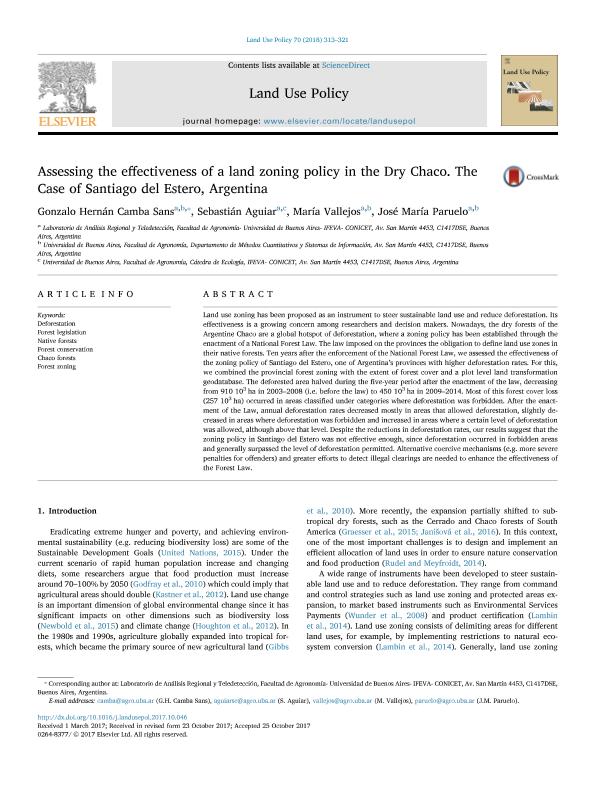Mostrar el registro sencillo del ítem
dc.contributor.author
Camba Sans, Gonzalo Hernán

dc.contributor.author
Aguiar, Sebastián

dc.contributor.author
Vallejos, María

dc.contributor.author
Paruelo, José

dc.date.available
2020-01-13T19:36:07Z
dc.date.issued
2018-01
dc.identifier.citation
Camba Sans, Gonzalo Hernán; Aguiar, Sebastián; Vallejos, María; Paruelo, José; Assessing the effectiveness of a land zoning policy in the Dry Chaco: The Case of Santiago del Estero, Argentina; Pergamon; Land Use Policy; 70; 1-2018; 313-321
dc.identifier.issn
0264-8377
dc.identifier.uri
http://hdl.handle.net/11336/94561
dc.description.abstract
Land use zoning has been proposed as an instrument to steer sustainable land use and reduce deforestation. Its effectiveness is a growing concern among researchers and decision makers. Nowadays, the dry forests of the Argentine Chaco are a global hotspot of deforestation, where a zoning policy has been established through the enactment of a National Forest Law. The law imposed on the provinces the obligation to define land use zones in their native forests. Ten years after the enforcement of the National Forest Law, we assessed the effectiveness of the zoning policy of Santiago del Estero, one of Argentina’s provinces with higher deforestation rates. For this, we combined the provincial forest zoning with the extent of forest cover and a plot level land transformation geodatabase. The deforested area halved during the five-year period after the enactment of the law, decreasing from 910 103 ha in 2003–2008 (i.e. before the law) to 450 103 ha in 2009–2014. Most of this forest cover loss (257 103 ha) occurred in areas classified under categories where deforestation was forbidden. After the enactment of the Law, annual deforestation rates decreased mostly in areas that allowed deforestation, slightly decreased in areas where deforestation was forbidden and increased in areas where a certain level of deforestation was allowed, although above that level. Despite the reductions in deforestation rates, our results suggest that the zoning policy in Santiago del Estero was not effective enough, since deforestation occurred in forbidden areas and generally surpassed the level of deforestation permitted. Alternative coercive mechanisms (e.g. more severe penalties for offenders) and greater efforts to detect illegal clearings are needed to enhance the effectiveness of the Forest Law.
dc.format
application/pdf
dc.language.iso
eng
dc.publisher
Pergamon

dc.rights
info:eu-repo/semantics/openAccess
dc.rights.uri
https://creativecommons.org/licenses/by-nc-sa/2.5/ar/
dc.subject
DEFORESTATION
dc.subject
FOREST LEGISLATION
dc.subject
NATIVE FORESTS
dc.subject
FOREST CONSERVATION
dc.subject
CHACO FORESTS
dc.subject
FOREST ZONING
dc.subject.classification
Ciencias Medioambientales

dc.subject.classification
Geografía Económica y Social

dc.subject.classification
CIENCIAS SOCIALES

dc.subject.classification
Otras Ciencias Naturales y Exactas

dc.subject.classification
Otras Ciencias Naturales y Exactas

dc.subject.classification
CIENCIAS NATURALES Y EXACTAS

dc.subject.classification
Ciencias Medioambientales

dc.subject.classification
Geografía Económica y Social

dc.subject.classification
CIENCIAS SOCIALES

dc.title
Assessing the effectiveness of a land zoning policy in the Dry Chaco: The Case of Santiago del Estero, Argentina
dc.type
info:eu-repo/semantics/article
dc.type
info:ar-repo/semantics/artículo
dc.type
info:eu-repo/semantics/publishedVersion
dc.date.updated
2019-10-23T21:13:22Z
dc.journal.volume
70
dc.journal.pagination
313-321
dc.journal.pais
Reino Unido

dc.journal.ciudad
Oxford
dc.description.fil
Fil: Camba Sans, Gonzalo Hernán. Universidad de Buenos Aires. Facultad de Agronomía. Departamento de Métodos Cuantitativos y Sistemas de Información; Argentina. Consejo Nacional de Investigaciones Científicas y Técnicas. Oficina de Coordinación Administrativa Parque Centenario. Instituto de Investigaciones Fisiológicas y Ecológicas Vinculadas a la Agricultura. Universidad de Buenos Aires. Facultad de Agronomía. Instituto de Investigaciones Fisiológicas y Ecológicas Vinculadas a la Agricultura; Argentina
dc.description.fil
Fil: Aguiar, Sebastián. Consejo Nacional de Investigaciones Científicas y Técnicas. Oficina de Coordinación Administrativa Parque Centenario. Instituto de Investigaciones Fisiológicas y Ecológicas Vinculadas a la Agricultura. Universidad de Buenos Aires. Facultad de Agronomía. Instituto de Investigaciones Fisiológicas y Ecológicas Vinculadas a la Agricultura; Argentina
dc.description.fil
Fil: Vallejos, María. Universidad de Buenos Aires. Facultad de Agronomía. Departamento de Métodos Cuantitativos y Sistemas de Información; Argentina. Consejo Nacional de Investigaciones Científicas y Técnicas. Oficina de Coordinación Administrativa Parque Centenario. Instituto de Investigaciones Fisiológicas y Ecológicas Vinculadas a la Agricultura. Universidad de Buenos Aires. Facultad de Agronomía. Instituto de Investigaciones Fisiológicas y Ecológicas Vinculadas a la Agricultura; Argentina
dc.description.fil
Fil: Paruelo, José. Consejo Nacional de Investigaciones Científicas y Técnicas. Oficina de Coordinación Administrativa Parque Centenario. Instituto de Investigaciones Fisiológicas y Ecológicas Vinculadas a la Agricultura. Universidad de Buenos Aires. Facultad de Agronomía. Instituto de Investigaciones Fisiológicas y Ecológicas Vinculadas a la Agricultura; Argentina. Universidad de Buenos Aires. Facultad de Agronomía. Departamento de Métodos Cuantitativos y Sistemas de Información; Argentina
dc.journal.title
Land Use Policy

dc.relation.alternativeid
info:eu-repo/semantics/altIdentifier/url/https://www.sciencedirect.com/science/article/pii/S0264837717301710
dc.relation.alternativeid
info:eu-repo/semantics/altIdentifier/doi/http://dx.doi.org/10.1016/j.landusepol.2017.10.046
Archivos asociados
